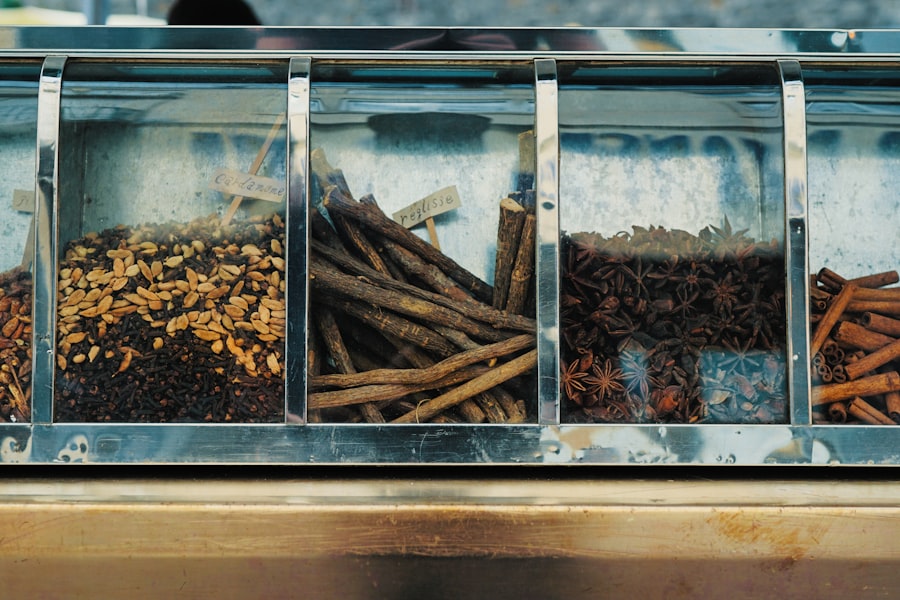Cinnamon has a rich history spanning thousands of years. Ancient Egyptians valued it highly, using it in embalming rituals. In ancient Rome and Greece, cinnamon was considered a luxury and often given as gifts to monarchs and gods.
During medieval times, cinnamon became one of Europe’s most sought-after spices, sometimes used as currency. The demand for cinnamon drove European exploration and colonization efforts to control the spice trade. Today, cinnamon is widely used in global cuisines for its warm, sweet flavor and aromatic qualities.
Cinnamon sticks are made from the inner bark of the Cinnamomum tree, native to Sri Lanka and parts of Southeast Asia. The harvested bark is dried, naturally curling into the familiar stick shape. Cinnamon sticks have been used in cooking and baking for centuries, becoming a staple ingredient in many traditional dishes across various cultures.
Beyond culinary applications, cinnamon has been utilized for its medicinal properties in traditional medicine systems like Ayurveda and traditional Chinese medicine. The enduring popularity and versatility of cinnamon sticks are evident throughout human history.
Key Takeaways
- Cinnamon stick has a rich history dating back to ancient Egypt and is mentioned in the Bible and other ancient texts.
- Health benefits of cinnamon stick include its anti-inflammatory, antioxidant, and antimicrobial properties, as well as its potential to lower blood sugar and cholesterol levels.
- Cinnamon stick is commonly used in both sweet and savory dishes, such as curries, desserts, and hot beverages.
- To store cinnamon stick, keep it in an airtight container in a cool, dark place to preserve its flavor and aroma.
- Cinnamon stick can be used in home remedies for cold and flu relief, digestion, and as a natural insect repellent.
Health Benefits of Cinnamon Stick
Antioxidant and Anti-Inflammatory Properties
Cinnamon contains high levels of antioxidants, which can help protect the body from oxidative damage caused by free radicals. These antioxidants may also have anti-inflammatory properties, which can help reduce inflammation in the body.
Antimicrobial Properties and Blood Sugar Management
Additionally, cinnamon has been shown to have antimicrobial properties, which can help fight off bacteria and fungi. This makes cinnamon sticks a valuable ingredient for promoting overall health and well-being. Furthermore, cinnamon has been studied for its potential role in managing blood sugar levels. Some research suggests that cinnamon may help improve insulin sensitivity and lower blood sugar levels, making it a potentially valuable tool for managing diabetes.
Heart Health and Neuroprotective Properties
Cinnamon sticks are also rich in compounds that may help lower cholesterol levels, which can contribute to heart health. Additionally, some studies have suggested that cinnamon may have neuroprotective properties, which could potentially benefit brain health.
While more research is needed to fully understand the extent of these health benefits, the potential medicinal properties of cinnamon sticks make them a valuable addition to a healthy diet.
Culinary Uses of Cinnamon Stick

Cinnamon sticks are a versatile ingredient that can be used in a wide variety of culinary applications. They are commonly used in both sweet and savory dishes, adding warmth and depth of flavor to recipes. In many cultures, cinnamon sticks are used to flavor rice dishes, curries, stews, and soups.
They are also a popular addition to hot beverages such as mulled wine, cider, and tea, infusing the drinks with their distinctive aroma and flavor. In baking, cinnamon sticks are often used to infuse flavor into custards, puddings, and baked goods such as cakes, cookies, and pastries. One of the most popular uses for cinnamon sticks is in making spiced syrups and infusions.
By simmering cinnamon sticks with water and sugar, a fragrant syrup can be created that can be used to sweeten cocktails, coffee drinks, and desserts. Cinnamon sticks can also be used to infuse flavor into spirits such as rum or whiskey, creating unique and aromatic liquors for use in cocktails. The versatility of cinnamon sticks in the kitchen makes them a valuable ingredient for adding warmth and complexity to a wide range of dishes and beverages.
How to Store Cinnamon Stick
| Storage Method | Duration |
|---|---|
| Store in airtight container | 1-2 years |
| Avoid moisture and sunlight | – |
| Keep in a cool, dark place | – |
Proper storage is essential for preserving the flavor and aroma of cinnamon sticks. To keep them fresh for as long as possible, it is important to store them in an airtight container in a cool, dark place. This will help protect the sticks from exposure to light, heat, and moisture, which can degrade their quality over time.
It is also important to keep cinnamon sticks away from strong-smelling foods, as they can absorb odors easily. If stored properly, whole cinnamon sticks can retain their flavor for up to two years. Ground cinnamon, on the other hand, has a shorter shelf life and should be used within six months for the best flavor.
To check if your cinnamon sticks are still fresh, simply give them a sniff – they should have a strong, sweet aroma. If the scent is weak or nonexistent, it may be time to replace them with fresh sticks.
Cinnamon Stick in Home Remedies
Cinnamon sticks have been used for centuries in traditional medicine systems for their potential health benefits. They are believed to have antimicrobial properties that can help fight off infections and boost the immune system. In some cultures, cinnamon sticks are used to make teas or infusions that are believed to help alleviate symptoms of colds and flu.
Additionally, cinnamon sticks are often used in aromatherapy for their soothing and calming scent, which can help reduce stress and promote relaxation. In Ayurveda, the traditional medicine system of India, cinnamon sticks are believed to have warming properties that can help improve digestion and circulation. They are often used in herbal preparations to support digestive health and alleviate symptoms of indigestion or bloating.
Some people also use cinnamon sticks topically as part of homemade remedies for skin conditions such as acne or eczema. While more research is needed to fully understand the extent of these potential benefits, the use of cinnamon sticks in home remedies is a testament to their long-standing reputation as a natural remedy for various ailments.
Cinnamon Stick in Beauty and Skincare

Cinnamon sticks are not only valued for their culinary and medicinal properties but also for their potential benefits in beauty and skincare. The antimicrobial properties of cinnamon make it a popular ingredient in natural skincare products such as soaps and lotions. It is believed to help fight off acne-causing bacteria and promote clear, healthy skin.
Additionally, the warming properties of cinnamon may help improve circulation when applied topically, which can contribute to a healthy complexion. Cinnamon sticks are also used in DIY beauty treatments such as exfoliating scrubs and masks. When ground into a fine powder, cinnamon can be mixed with other natural ingredients such as honey or yogurt to create a gentle exfoliant that helps remove dead skin cells and promote a radiant glow.
Some people also use cinnamon-infused oils or extracts as part of their hair care routine, believing that it can help promote hair growth and improve scalp health. While it is important to use caution when using cinnamon topically due to its potential for skin irritation, many people find that incorporating cinnamon sticks into their beauty regimen can provide natural benefits for their skin and hair.
Cinnamon Stick in Holiday Decorations and Crafts
Cinnamon sticks are not only valued for their flavor and aroma but also for their decorative and aromatic qualities. During the holiday season, cinnamon sticks are often used in decorations and crafts due to their warm scent and rustic appearance. They can be used to create fragrant ornaments by tying them with ribbons or twine and hanging them on Christmas trees or wreaths.
Cinnamon sticks can also be used to make potpourri or sachets that add a festive touch to the home while filling the air with their sweet aroma. In addition to decorations, cinnamon sticks are also used in crafting projects such as homemade candles or wreaths. They can be incorporated into candle-making by embedding them into wax or tying them around the outside of candles for a decorative touch.
Cinnamon sticks can also be used to create unique wreaths by arranging them in a circular shape with other natural materials such as dried flowers or pinecones. The use of cinnamon sticks in holiday decorations and crafts adds a touch of warmth and nostalgia to the festive season while infusing the home with their delightful scent. In conclusion, the history of cinnamon sticks is a testament to their enduring popularity and versatility in various aspects of human life.
From their ancient origins as a prized spice to their modern-day uses in cooking, medicine, beauty, and crafts, cinnamon sticks continue to be valued for their flavor, aroma, and potential health benefits. Whether used in traditional dishes or incorporated into homemade remedies and decorations, cinnamon sticks remain a beloved ingredient that adds warmth and depth to our lives.
If you’re interested in learning more about the health benefits of cinnamon sticks, you should check out this article on limnanthemum.com. This website provides in-depth information on the various uses and advantages of using cinnamon sticks in cooking and for medicinal purposes. It’s a great resource for anyone looking to incorporate more natural remedies into their daily routine.
FAQs
What is a cinnamon stick?
A cinnamon stick is a dried, rolled-up bark from the Cinnamomum tree, commonly used as a spice in cooking and baking.
How is a cinnamon stick used in cooking?
Cinnamon sticks are often used to infuse flavor into hot beverages like tea and mulled wine, as well as in savory dishes like curries and stews. They can also be used as a garnish or stir stick.
Can you eat a cinnamon stick?
Cinnamon sticks are not typically eaten whole, as they are quite hard and fibrous. They are usually used to flavor dishes and then removed before serving.
How long do cinnamon sticks last?
When stored in a cool, dry place, cinnamon sticks can last for up to a year. It’s best to store them in an airtight container to maintain their flavor and aroma.
What are the health benefits of cinnamon sticks?
Cinnamon sticks are believed to have anti-inflammatory and antioxidant properties, and may help regulate blood sugar levels. However, it’s important to consume them in moderation as part of a balanced diet.



